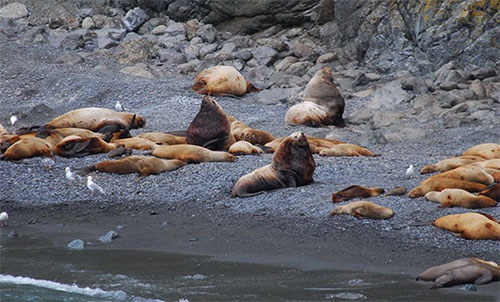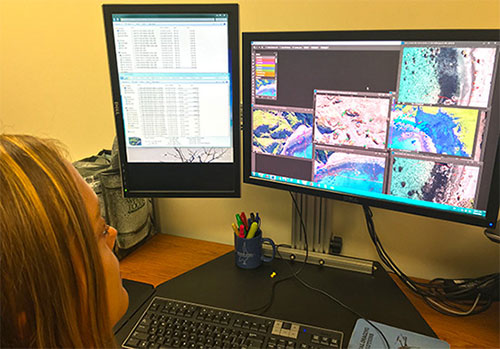
Mixing new technology and people power for an accurate count of endangered Steller sea lionsBy KATIE DOPTIS
October 02, 2016
Every summer AFSC’s Marine Mammal Lab scientists conduct Steller sea lion surveys along the Aleutian Island chain, an area of concern for the endangered Steller sea lion. Sea lions in the central and western Aleutian Islands have continued to decline.
Seeing a permanently marked Steller sea lion (center) is invaluable for estimating important information about the population, like survival and birth rates.
Advanced technology like hexacopter drones offer easier access to hard to reach locations where Steller sea lions live. Sophisticated maps and data visualizations clearly showcase detailed information and effectively demonstrate patterns and trends, especially to the general public. All of this leads to better insights and more accurate assessments about the health of the endangered population.
Biologist Katie Sweeney pieces together pictures of large Steller sea lions sites to count each animal.
“It’s pretty meditative [work],” said Marine Mammal Lab biologist Katie Sweeney. Sweeney and another MML researcher are working independently to make sure counts are accurate. If there is a big discrepancy from a certain area, both will recount. “We have to look at each image and puzzle the site together from multiple images, so it can take a couple of months” to count sea lions from all the photos. For now, the painstaking work will continue through fall. But the end result will be an accurate picture of how many Steller sea lions are living in the Aleutian Islands. The final figures will be reported this winter.
On the Web:
Editing by Mary Kauffman, SitNews
Source of News:
Representations of fact and opinions in comments posted are solely those of the individual posters and do not represent the opinions of Sitnews.
|
||

